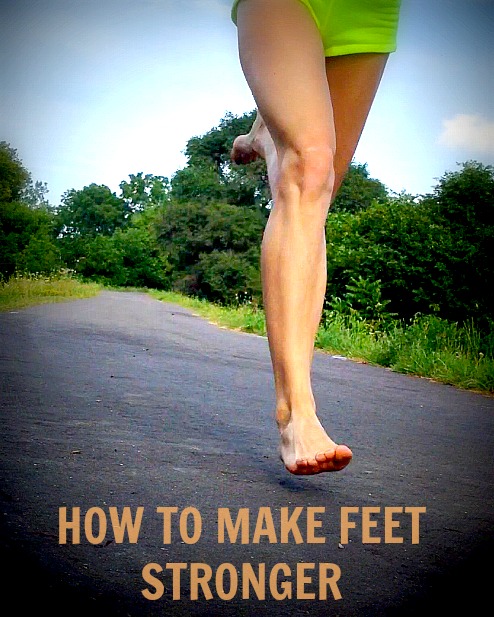Running barefoot is the best foot strengthening method because it increases foot bone strength. The best strategy to strengthen the foot bones for forefoot running is by increasing daily barefoot activity such as walking, even doing household chores while barefoot.

Best Method for Foot Strengthening
Simply being barefoot as much as possible increases intrinsic muscle activation. The increase in intrinsic muscle activation is the key to strengthening connective tissues surrounding the arch, allowing for better transferring of impact over the foot’s musculature.
For years the prevailing view was that the human foot is inherently weak and the shape of the foot predisposes runners to develop injuries such as metatarsal stress fractures and plantar fasciitis.
To run without injury, additional protection is required. But that idea fell by the wayside as we learned more about the effects on running-related injury prevention through barefoot adaptations.
Robbins and Hanna (1987), instructed habitual shod runners to increase barefoot weight-bearing activity as much as possible, over a 4 month period, both at home as well as outdoors and barefoot running and walking was strongly encouraged.
Unsurprisingly, the researchers found that barefoot walking/running ultimately set off a cascade of positive changes that led to stronger feet.
The foot bones increase in strength primarily by the increase in activation of the intrinsic musculature which enhanced medial arch rising and shortening, allowing the foot to dynamically dampen impact.
Better Arch Height, Less Pain
Running barefoot also heightened muscular contractions of the foot which affected the rising of the arch and toe plantar-flexion.
The researchers reasoned that the barefoot-related adaptations may be responsible for the low pain threshold of the foot in habitual barefoot runners because these runners unknowingly activate the intrinsic foot shock absorption system to make running barefoot comfortable by avoiding footfalls on more sensitive locations -more proof that humans are genetically hardwired to run with a forefoot strike.
Uneven Surfaces Works Best
The researchers also found that the greatest adaptation of the foot came from running and walking barefoot on uneven surfaces. Why? The researchers affirmed that the plantar sensory feedback may induce intrinsic foot shock absorption.
No More Plantar Fasciitis
Another key finding was that increased intrinsic muscle tone of the foot enhanced medial arch shortening which may alleviate inflammation of the plantar fascia.
The traditional running shoe causes plantar fasciitis by reducing intrinsic muscle tone and prevents transferring of impact to the foot musculature, meanwhile connective tissue that supports the medial longitudinal arch progressively weakens.
The heightened intrinsic muscle tone induced by running and/or walking barefoot resulted in adaptations of the foot capable of transferring this impact to the yielding musculature, thus sparing the fascia. The finding jives with other work which found that plantar fasciitis is very low in traditionally barefoot populations.
The Take Home Message
Go barefoot as much as possible to strengthen your feet for forefoot running because barefoot activity increases exposure to the selective impacts that improve the physical traits of the foot.
Being barefoot was a big part of our evolutionary timeline, therefore we have the innate capacity to do so and benefit greatly from it.
More From Run Forefoot:
- Best Barefoot Shoe for the Cooler Months
- Popular Mizuno Shoes for Forefoot Running
- 25+ Reasons Why Heel Strike Running Is Bad
- Why Your Feet Are Weak to Begin With
- Best Barefoot Shoe Brands
References:
Robbins, SE and Hanna, AM. Running related injury prevention through barefoot adaptations. Med Sci Sport Exerc, 1987; 19(2):148-56.
Bretta Riches
BSc Neurobiology; MSc Biomechanics candidate, ultra minimalist runner & founder of RunForefoot. I was a heel striker, always injured. I was inspired by the great Tirunesh Dibaba to try forefoot running. Now, I'm injury free. This is why I launched Run Forefoot, to advocate the health & performance benefits of forefoot running and to raise awareness on the dangers of heel striking, because the world needs to know.
Latest posts by Bretta Riches (see all)
- Does Foot Strike Really Matter in Running? YES! - 17/04/2024
- Heel Lifts Increase Injury in Runners - 16/04/2024
- Are Minimalist Shoes Good for Seniors? YES! - 14/04/2024

Leave a Reply